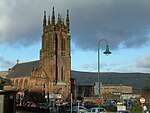Back O'Loch Halt railway station
Beeching closures in ScotlandDisused railway stations in East DunbartonshireFormer London and North Eastern Railway stationsPages with no open date in Infobox stationRailway stations in Great Britain closed in 1964 ... and 2 more
Railway stations in Great Britain opened in 1925Use British English from May 2017
Back O'Loch Halt railway station on the Edinburgh and Glasgow Railway built Campsie Branch served part of Kirkintilloch in Scotland.
Excerpt from the Wikipedia article Back O'Loch Halt railway station (License: CC BY-SA 3.0, Authors).Back O'Loch Halt railway station
Initiative Road,
Geographical coordinates (GPS) Address Nearby Places Show on map
Geographical coordinates (GPS)
| Latitude | Longitude |
|---|---|
| N 55.934 ° | E -4.151 ° |
Address
Initiative Road
G66 3AE , Barleybank
Scotland, United Kingdom
Open on Google Maps








